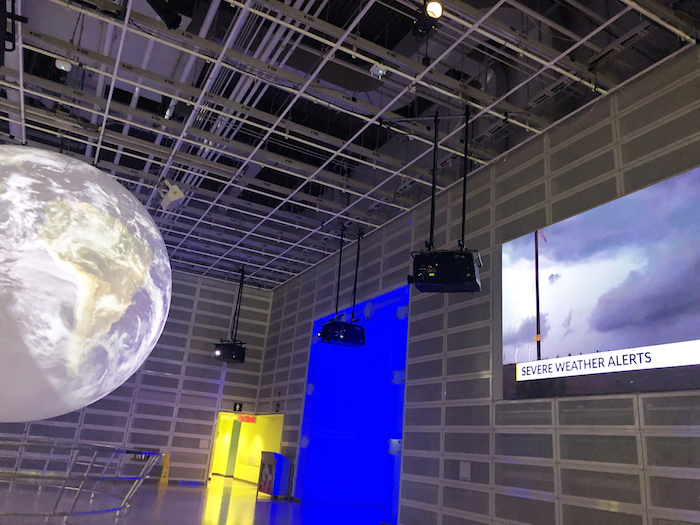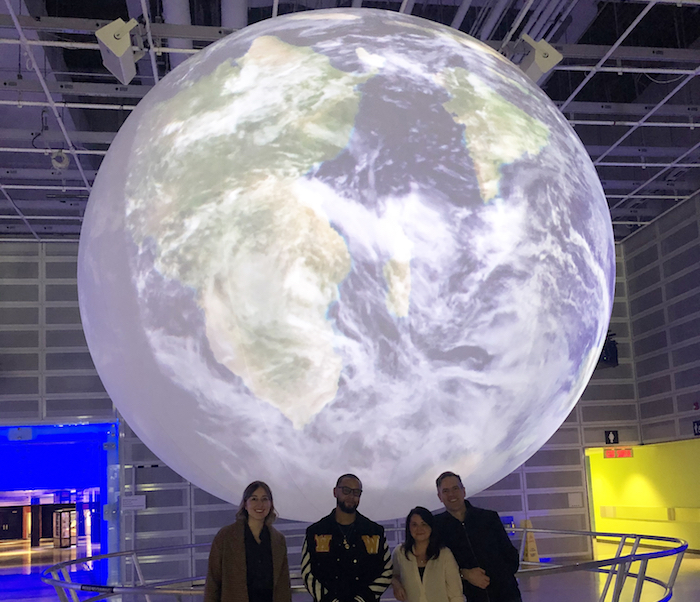Since the mid-1990s, Director X has made a name for himself by making videos for some of the world's biggest stars. Drake. Rihanna. Justin Bieber. Kendrick Lamar. You name it.
Then in 2016, he made one for the biggest star, period. The Sun!
View this post on Instagram
It was called Death of the Sun, and it was shown as a multimedia film during the Toronto outdoor art festival, Nuit Blanche. The film projected the Sun's entire lifespan, including its future final moments, and it was a huge success. Which means ... sequel!
That's how Director X arrived at his newest project, Life of the Earth. Both it and Death of the Sun are showing right now at the Ontario Science Centre in Toronto ... and we went to see them for ourselves, as well as speak to the director himself!
Earth, this is your life!

For both films, the screen is the star of the show! (Owlkids)
Life of the Earth may only be six minutes long, but it is a lot to take in.
It has multiple screens and a collection of sounds ranging from dinosaur roars and bird calls to the clashing of swords and news reports. But the first thing that you notice is its massive 16.75 metre (55-foot) wide spherical screen. This huge feature offers a 360° view of the Earth itself ... and is a lot more secure when shown indoors!
"(The screen) actually blew away at one point and got busted," Director X laughed about preparing for Nuit Blanche in 2016. "We had to get another one made!"
The films begins in the Mesozoic Era (a.k.a. the Age of Reptiles), and quickly we hear the familiar Jurassic stomps. Then hundreds of millions of years of our planet's history pass right before our eyes. We see continents move and shift until they reach their present locations. It's really neat watching present day India glide across the ocean until it meets the rest of Asia!
And then humans appear ... and the film gets a bit heavier.
On a mission

Life of the Earth shows how humanity's time has affected the planet. (Owlkids)
On one hand, the 360° screen means that every time you view it, you can stand in a new spot and watch certain cities and civilizations pop up. (Hint: the best viewing for this is found on the night side, when the lights of cities appear!) Each viewing is a little different!
As fascinating as this all is, though, the film has a very serious message. It does not end in the present day. Instead, it moves thousands of years into the future, basing its conclusions on current climate science. By the final moments, much of the Earth is dry and water levels are noticeably high.
Despite this, Director X is excited by the way that young people are fighting for the environment. And it gives him hope.
"I think change is going to happen," said Director X. "It’s got to happen. Once you’ve got the kids doing it, then you know you’ve reached a tipping point. That can’t be stopped.
Life goes on
So what did we think of these two movies? Having both of them in the same place is awesome. And because you can watch them in about twenty minutes, it's easy to just sit and hang out, re-watch them, and let your mind wander. They're perfect back-to-back!
But the biggest difference? Life of the Earth doesn't end with our planet's death. This is also the film's one big truth: No matter how much the planet changes, it will still be here, in one form or another. So the big question is ...
What will we do to make sure the future Earth is a green and healthy place?
If that's a question you'd like to think about some more, Life of the Earth and Death of the Sun will be playing at the Ontario Science Centre until January 5, 2020. It's free with admission.
 We visited the Ontario Science Centre and hung with Director X! (Owlkids)
We visited the Ontario Science Centre and hung with Director X! (Owlkids)










Woah!